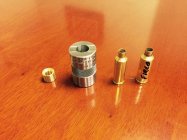If you’ve been neck sizing only then over a number of firings and allowing the case to continue to grow in length it has finally reached the point where it has become too long for that chamber. Not talking about overall length either, it’s not something that’ll get fixed by trimming. Instead, it has grown too long measuring from the base to the case to the case shoulder datum and what you’ve been feeling whilst closing the bolt on a case that’s too long is the bolt face shoving the base of a case that’s too long in body so whose shoulder is already firmly lodged up against the chamber’s shoulder. With the bolt closed on that piece of brass inside that chamber, headspace is somewhere between none and something less than zero.
You need to push the case shoulder back just enough so that when the case’s shoulder is butted to the chamber’s shoulder there will still be ~ a thousandth or two of clearance between the base of the case and the face of a fully closed bolt (headspace, with that case). You’ll need to, by whatever means, adjust how much of the case’s length enters and so will be acted on by the die once the press ram is peaked at the top of its stroke.
You need to push the case shoulder back just enough so that when the case’s shoulder is butted to the chamber’s shoulder there will still be ~ a thousandth or two of clearance between the base of the case and the face of a fully closed bolt (headspace, with that case). You’ll need to, by whatever means, adjust how much of the case’s length enters and so will be acted on by the die once the press ram is peaked at the top of its stroke.











